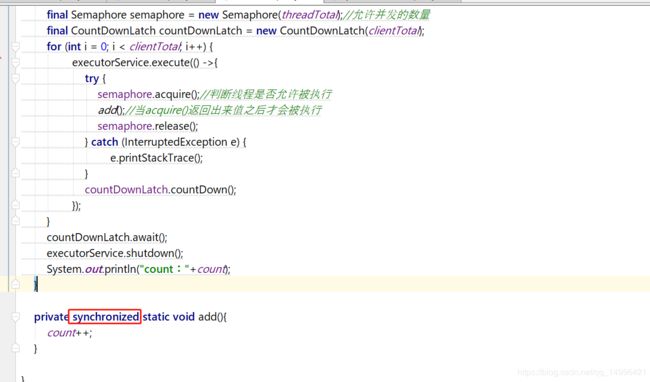【学习笔记】线程原子性-锁 synchronized的用法
线程安全性的定义:
当多个线程访问某个类的时候,不管运行时环境采用何种调度方式或者这些进程将如何交替执行,并且在主调代码中不需要任何额外的同步或者协同,这个类都能表现出正确的行为,那么我们就称则这个类是线程安全的
原子性的锁有两种:
synchronized:是Java中的关键字,是一种同步锁,依赖于JVM
Lock:依赖特殊的CPU指令,代码实现,ReentrantLock
这里我们先来了解synchronized
1、修饰代码块:大括号括起来的代码,作用于调用的对象
2、修饰方法:整个方法,作用于调用的对象
3、修饰静态方法:整个静态方法,作用于所有对象
4、修饰类:括号括起来的部分,作用于所有对象
修饰代码块
package com.lyy.concurrency.sync;
import java.util.concurrent.ExecutorService;
import java.util.concurrent.Executors;
public class SynchronizedExample1 {
// 修饰一个代码块
public void test1(int j){
synchronized (this){
for (int i = 0; i < 10; i++) {
System.out.println("test1 j:"+j+" — i:"+i);
}
}
}
public static void main(String[] args) {
SynchronizedExample1 example1 = new SynchronizedExample1();
SynchronizedExample1 example2 = new SynchronizedExample1();
ExecutorService executorService = Executors.newCachedThreadPool();//声明一个线程池
//加上线程池相当于我们调用了两个线程
//两个线程调用了同一个对象
executorService.execute(() ->{
example1.test1(1);
});
executorService.execute(() ->{
example2.test1(2);
});
}
}
返回结果:
test1 j:1 — i:0
test1 j:1 — i:1
test1 j:1 — i:2
test1 j:1 — i:3
test1 j:1 — i:4
test1 j:1 — i:5
test1 j:1 — i:6
test1 j:1 — i:7
test1 j:1 — i:8
test1 j:1 — i:9
test1 j:2 — i:0
test1 j:2 — i:1
test1 j:2 — i:2
test1 j:2 — i:3
test1 j:2 — i:4
test1 j:2 — i:5
test1 j:2 — i:6
test1 j:2 — i:7
test1 j:2 — i:8
test1 j:2 — i:9
线程1和线程2按照各自顺序执行,线程一和线程二都能够按照自己的同步代码走下去,但是不一定能保证线程一执行完之后才到线程二执行,这就要看哪一个线程能够率先抢到资源。
修饰方法
package com.lyy.concurrency.sync;
import java.util.concurrent.ExecutorService;
import java.util.concurrent.Executors;
public class SynchronizedExample1 {
//修饰一个方法
public synchronized void test2(int j){
for (int i = 0; i < 10; i++) {
System.out.println("test2 j:"+j+" — i:"+i);
}
}
public static void main(String[] args) {
SynchronizedExample1 example1 = new SynchronizedExample1();
SynchronizedExample1 example2 = new SynchronizedExample1();
ExecutorService executorService = Executors.newCachedThreadPool();//声明一个线程池
//加上线程池相当于我们调用了两个线程
//两个线程调用了同一个对象
executorService.execute(() ->{
example1.test2(1);
});
executorService.execute(() ->{
example2.test2(2);
});
}
}
返回结果:
test2 j:1 — i:0
test2 j:1 — i:1
test2 j:1 — i:2
test2 j:1 — i:3
test2 j:1 — i:4
test2 j:1 — i:5
test2 j:1 — i:6
test2 j:1 — i:7
test2 j:2 — i:0
test2 j:2 — i:1
test2 j:2 — i:2
test2 j:2 — i:3
test2 j:2 — i:4
test2 j:2 — i:5
test2 j:2 — i:6
test2 j:2 — i:7
test2 j:2 — i:8
test2 j:1 — i:8
test2 j:2 — i:9
test2 j:1 — i:9
我们可以看到1 和2 是交替运行的,但是各自都是按照顺序在执行,这里是因为修饰代码块只能作用于当前调用的对象,我们这里是调用了两个方法所以,两个线程则互不干扰,都是各自执行各自的代码,同步是整个方法
注意:如果SynchronizedExample1 是个子类 那么实现test2的时候是不会携带synchronized关键字 ,因为synchronized是不属于方法声明的一部分,因此,synchronized关键字不能被继承,如果想要去实现这个子类继承synchronized,需要我们手动是实现这个功能
修饰类
package com.lyy.concurrency.sync;
import java.util.concurrent.ExecutorService;
import java.util.concurrent.Executors;
public class SynchronizedExample2 {
// 修饰一个类
public static void test1(int j){
synchronized (SynchronizedExample2.class){
for (int i = 0; i < 10; i++) {
System.out.println("test1 j:"+j+" — i:"+i);
}
}
}
public static void main(String[] args) {
SynchronizedExample2 example1 = new SynchronizedExample2();
SynchronizedExample2 example2 = new SynchronizedExample2();
ExecutorService executorService = Executors.newCachedThreadPool();//声明一个线程池
//加上线程池相当于我们调用了两个线程 l
//两个线程调用了同一个对象
executorService.execute(() ->{
example1.test1(1);
});
executorService.execute(() ->{
example2.test1(2);
});
}
}
返回结果:
test1 j:1 — i:0
test1 j:1 — i:1
test1 j:1 — i:2
test1 j:1 — i:3
test1 j:1 — i:4
test1 j:1 — i:5
test1 j:1 — i:6
test1 j:1 — i:7
test1 j:1 — i:8
test1 j:1 — i:9
test1 j:2 — i:0
test1 j:2 — i:1
test1 j:2 — i:2
test1 j:2 — i:3
test1 j:2 — i:4
test1 j:2 — i:5
test1 j:2 — i:6
test1 j:2 — i:7
test1 j:2 — i:8
test1 j:2 — i:9
修饰静态方法
package com.lyy.concurrency.sync;
import java.util.concurrent.ExecutorService;
import java.util.concurrent.Executors;
public class SynchronizedExample2 {
//修饰一个静态方法
public static synchronized void test2(int j){
for (int i = 0; i < 10; i++) {
System.out.println("test2 j:"+j+" — i:"+i);
}
}
public static void main(String[] args) {
SynchronizedExample2 example1 = new SynchronizedExample2();
SynchronizedExample2 example2 = new SynchronizedExample2();
ExecutorService executorService = Executors.newCachedThreadPool();//声明一个线程池
//加上线程池相当于我们调用了两个线程 l
//两个线程调用了同一个对象
executorService.execute(() ->{
example1.test2(1);
});
executorService.execute(() ->{
example2.test2(2);
});
}
}
返回结果:
test2 j:1 — i:0
test2 j:1 — i:1
test2 j:1 — i:2
test2 j:1 — i:3
test2 j:1 — i:4
test2 j:1 — i:5
test2 j:1 — i:6
test2 j:1 — i:7
test2 j:1 — i:8
test2 j:1 — i:9
test2 j:2 — i:0
test2 j:2 — i:1
test2 j:2 — i:2
test2 j:2 — i:3
test2 j:2 — i:4
test2 j:2 — i:5
test2 j:2 — i:6
test2 j:2 — i:7
test2 j:2 — i:8
test2 j:2 — i:9
案例:
线程不安全案例:
package com.lyy.concurrency.example.count;
import java.util.concurrent.CountDownLatch;
import java.util.concurrent.ExecutorService;
import java.util.concurrent.Executors;
import java.util.concurrent.Semaphore;
public class CountExample1 {
//请求总数
public static int clientTotal = 5000;
//同时并发执行的线程数
public static int threadTotal = 200;
//
public static int count = 0;
public static void main(String[] args) throws Exception{
ExecutorService executorService = Executors.newCachedThreadPool();//线程池
final Semaphore semaphore = new Semaphore(threadTotal);//允许并发的数量
final CountDownLatch countDownLatch = new CountDownLatch(clientTotal);
for (int i = 0; i < clientTotal; i++) {
executorService.execute(() ->{
try {
semaphore.acquire();//判断线程是否允许被执行
add();//当acquire()返回出来值之后才会被执行
semaphore.release();
} catch (InterruptedException e) {
e.printStackTrace();
}
countDownLatch.countDown();
});
}
countDownLatch.await();
executorService.shutdown();
System.out.println("count:"+count);
}
private static void add(){
count++;
}
}
执行结果:
count:4973
我们看到执行结果是4973,而正确的执行结果应该是5000,那么我们怎么才能让结果显示为5000呢,就看接下来我们使用synchronized实现一个线程安全的类
线程安全的类:
package com.lyy.concurrency.example.count;
import com.lyy.concurrency.annoatioons.NotThreadSafe;
import com.lyy.concurrency.annoatioons.ThreadSafe;
import lombok.extern.slf4j.Slf4j;
import java.util.concurrent.CountDownLatch;
import java.util.concurrent.ExecutorService;
import java.util.concurrent.Executors;
import java.util.concurrent.Semaphore;
@Slf4j
@ThreadSafe //线程安全的类
public class CountExample3 {
//请求总数
public static int clientTotal = 5000;
//同时并发执行的线程数
public static int threadTotal = 200;
//
public static int count = 0;
public static void main(String[] args) throws Exception{
ExecutorService executorService = Executors.newCachedThreadPool();//线程池
final Semaphore semaphore = new Semaphore(threadTotal);//允许并发的数量
final CountDownLatch countDownLatch = new CountDownLatch(clientTotal);
for (int i = 0; i < clientTotal; i++) {
executorService.execute(() ->{
try {
semaphore.acquire();//判断线程是否允许被执行
add();//当acquire()返回出来值之后才会被执行
semaphore.release();
} catch (InterruptedException e) {
e.printStackTrace();
}
countDownLatch.countDown();
});
}
countDownLatch.await();
executorService.shutdown();
System.out.println("count:"+count);
}
private synchronized static void add(){
count++;
}
}
在这里我们加了一个synchronized,就可以使我们的结果显示为正确的5000
返回结果:
count:5000
总结:
1、synchronized:是不可中断锁,适合竞争不激烈,可读性比较好
2、无论synchronized关键字加在方法上还是对象上,如果它作用的对象是非静态的,则它取得的锁是对象;
3、如果synchronized作用的对象是一个静态方法或一个类,则它取得的锁是对类,该类所有的对象同一把锁。
4、每个对象只有一个锁(lock)与之相关联,谁拿到这个锁谁就可以运行它所控制的那段代码。
5、实现同步是要很大的系统开销作为代价的,甚至可能造成死锁,所以尽量避免无谓的同步控制。
